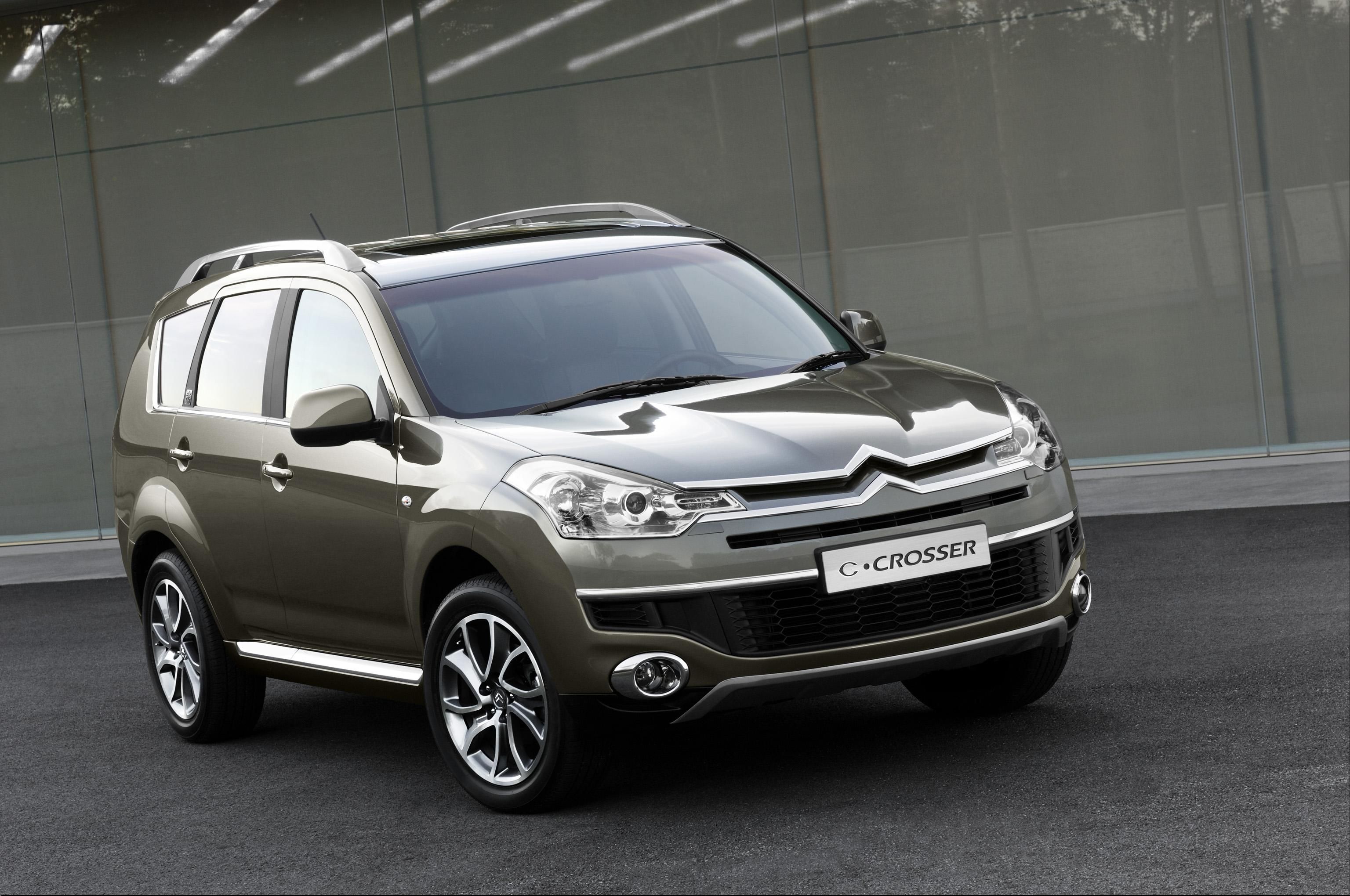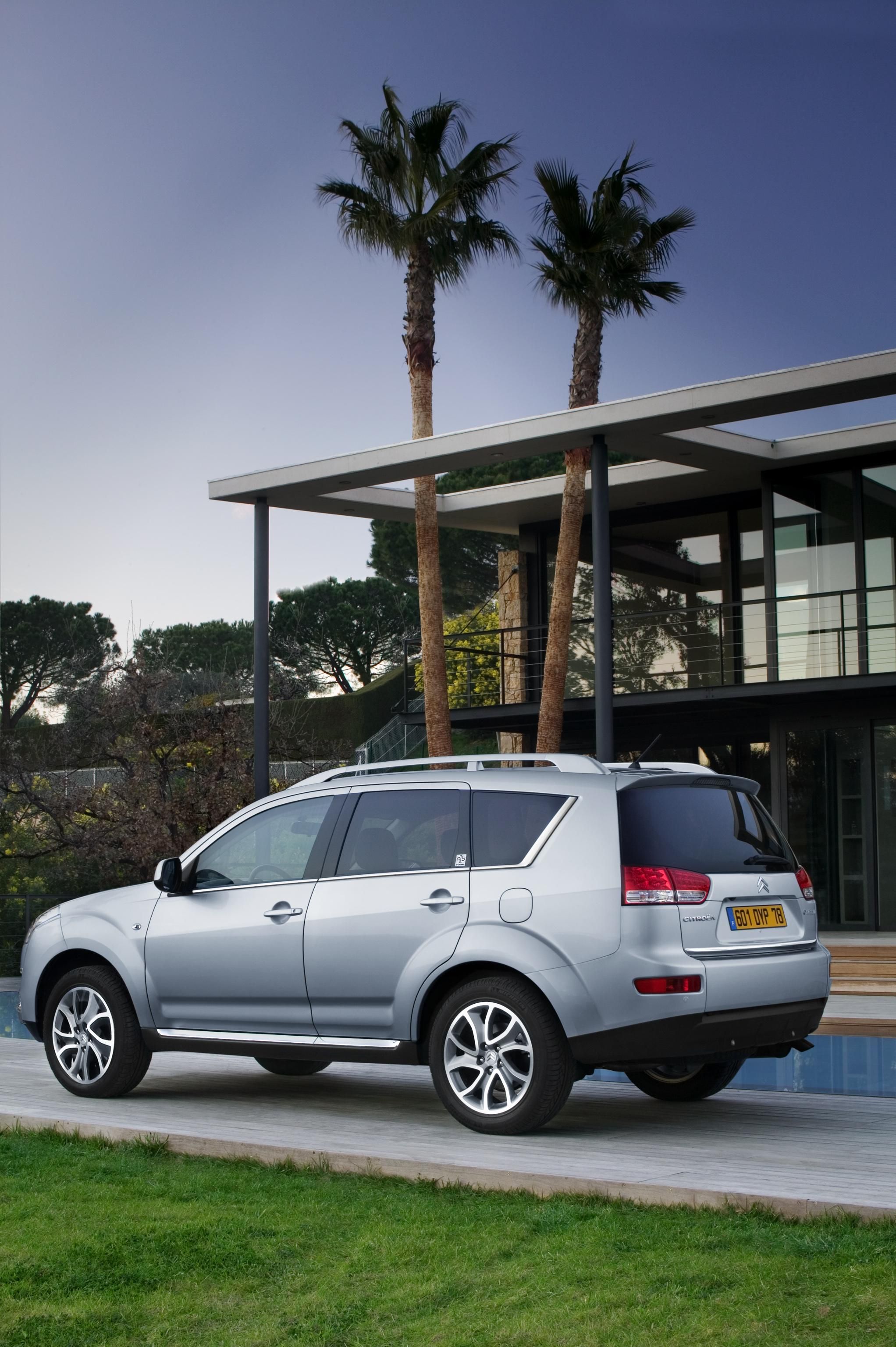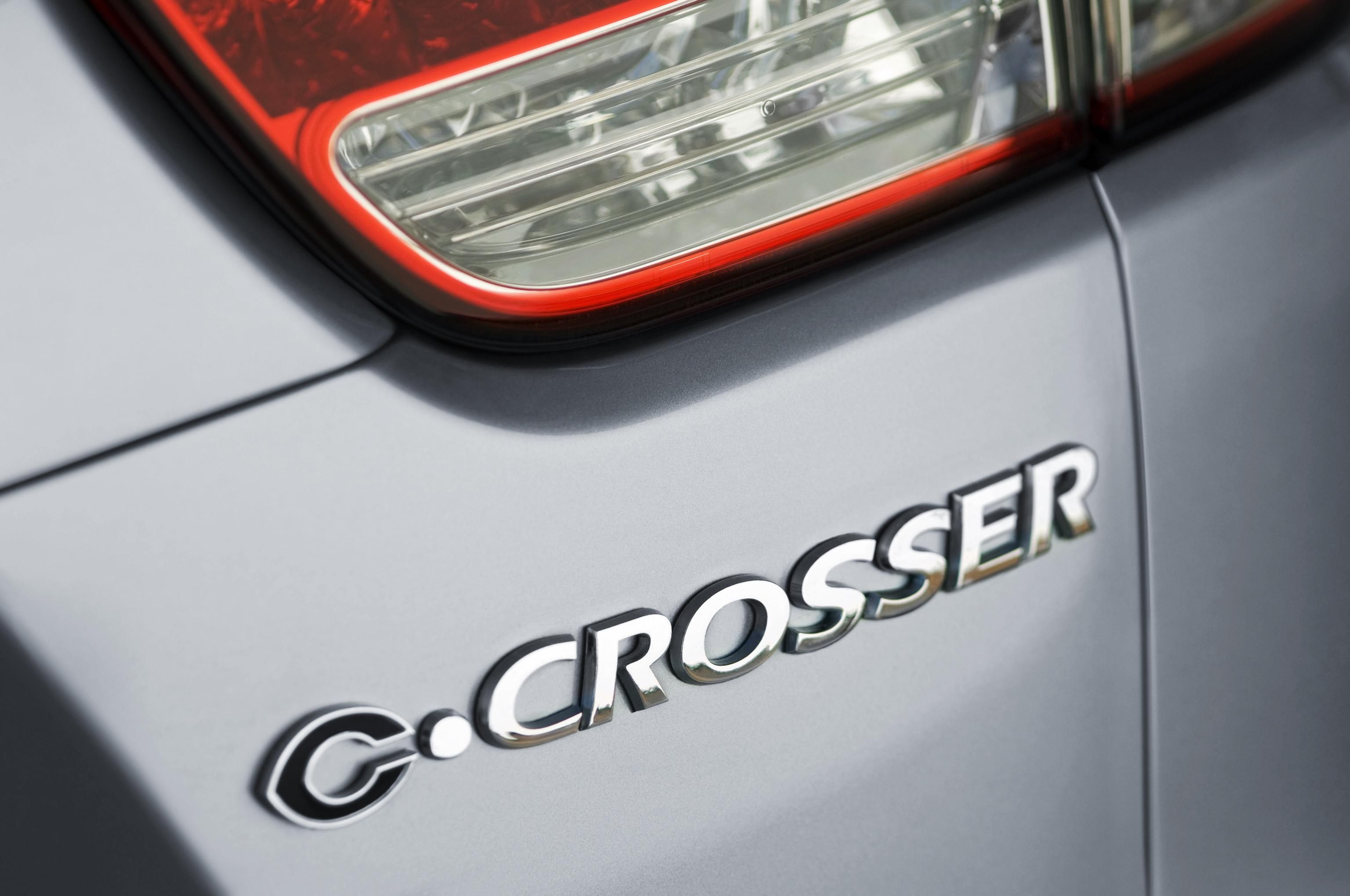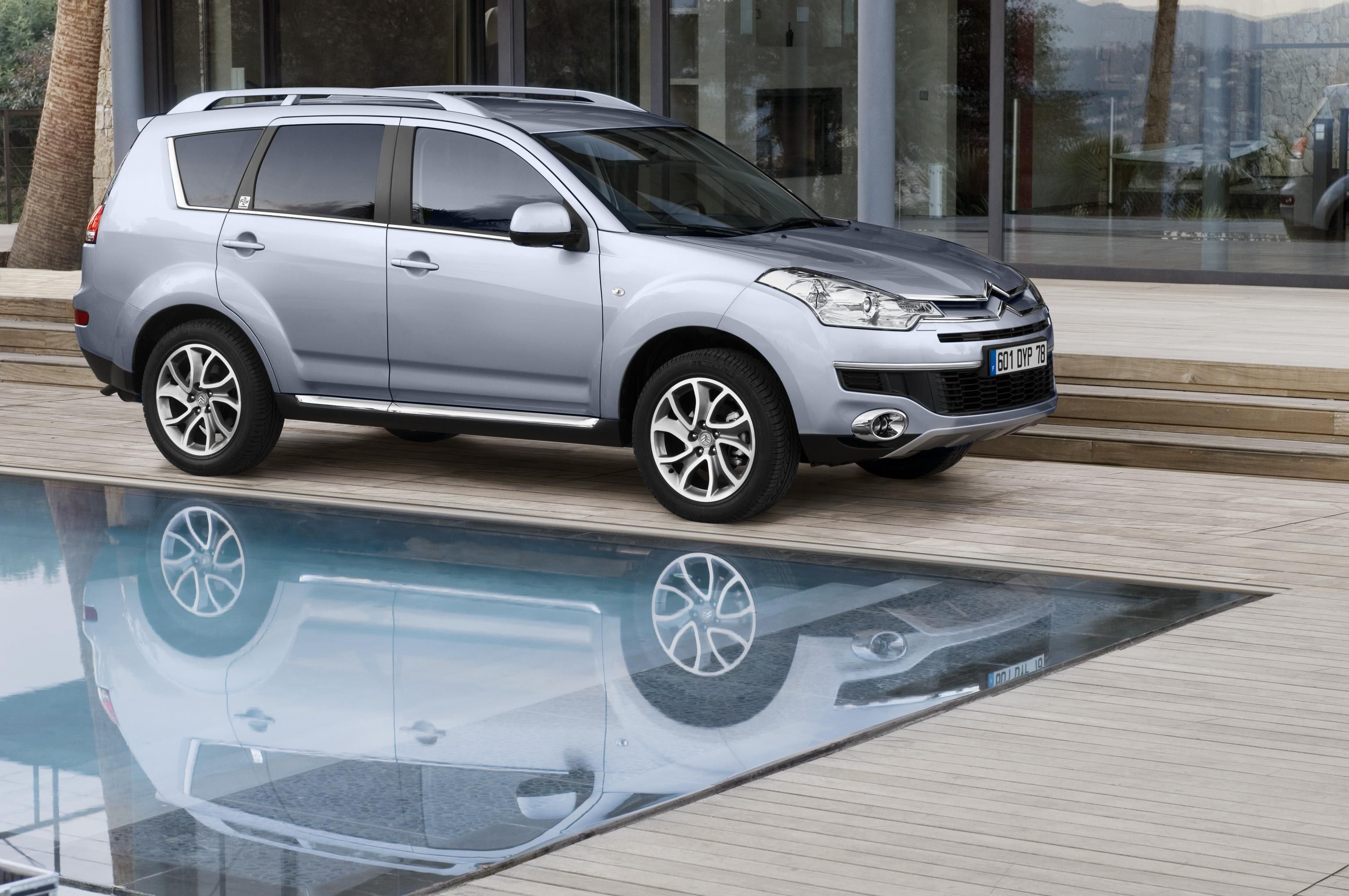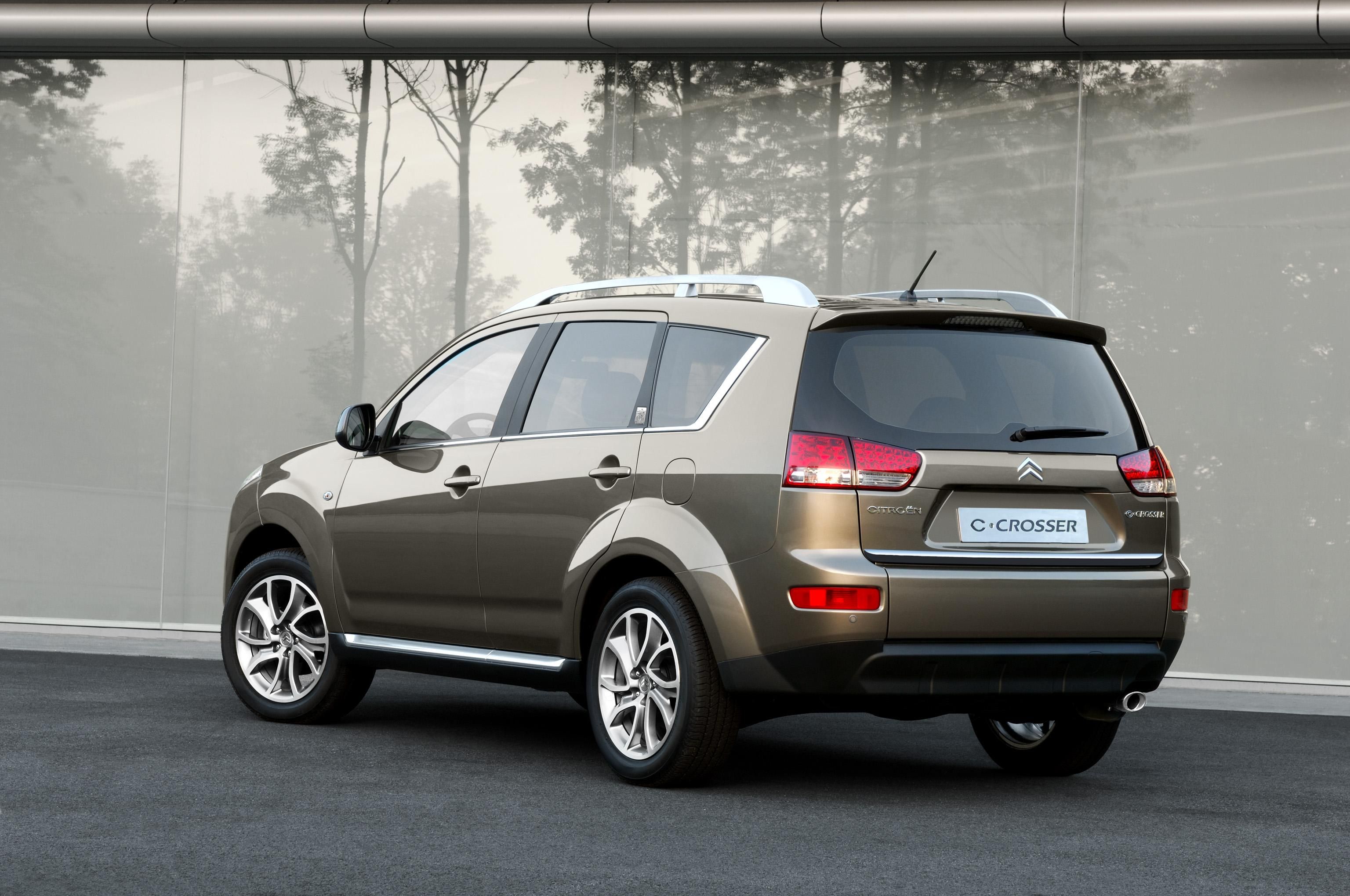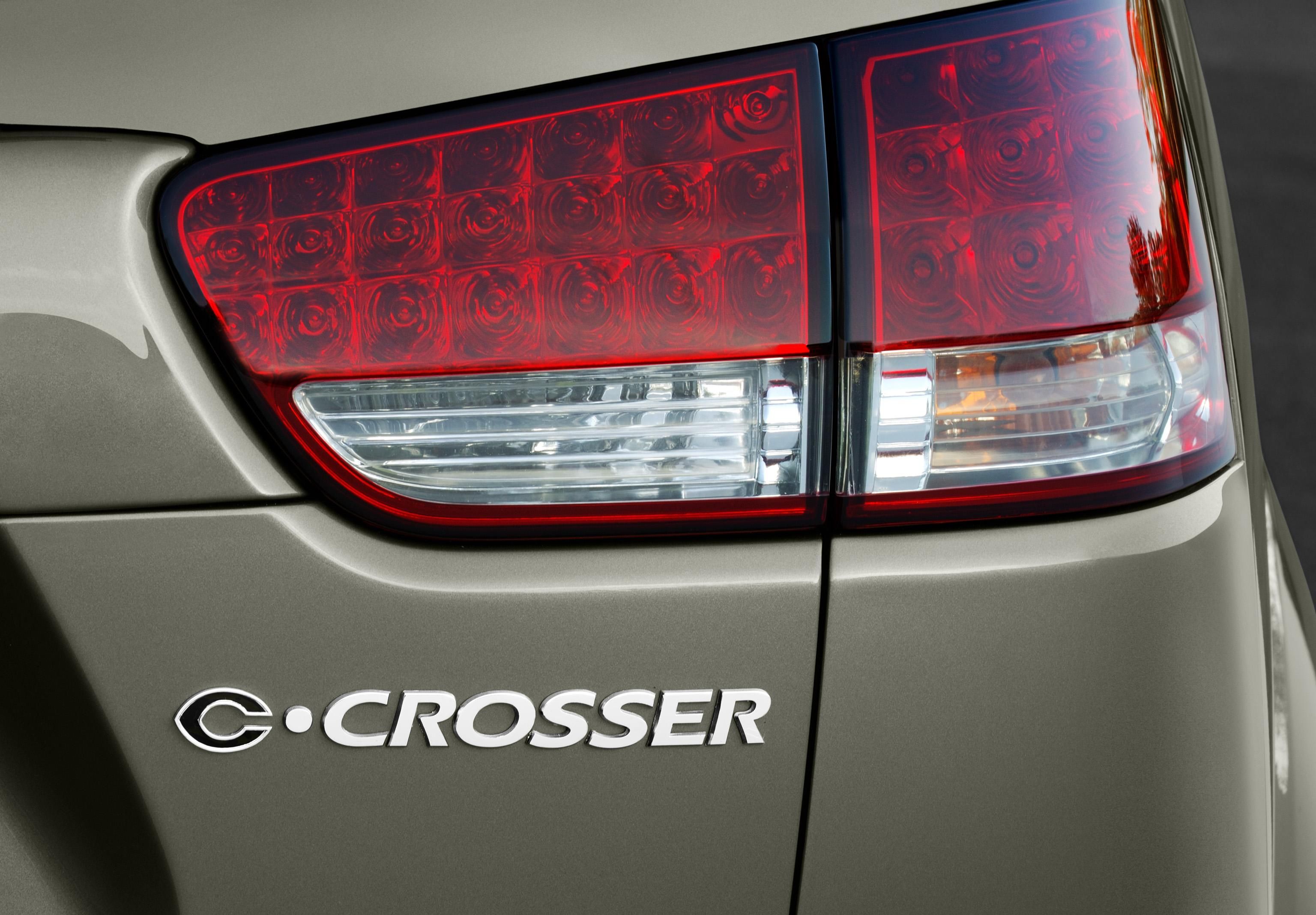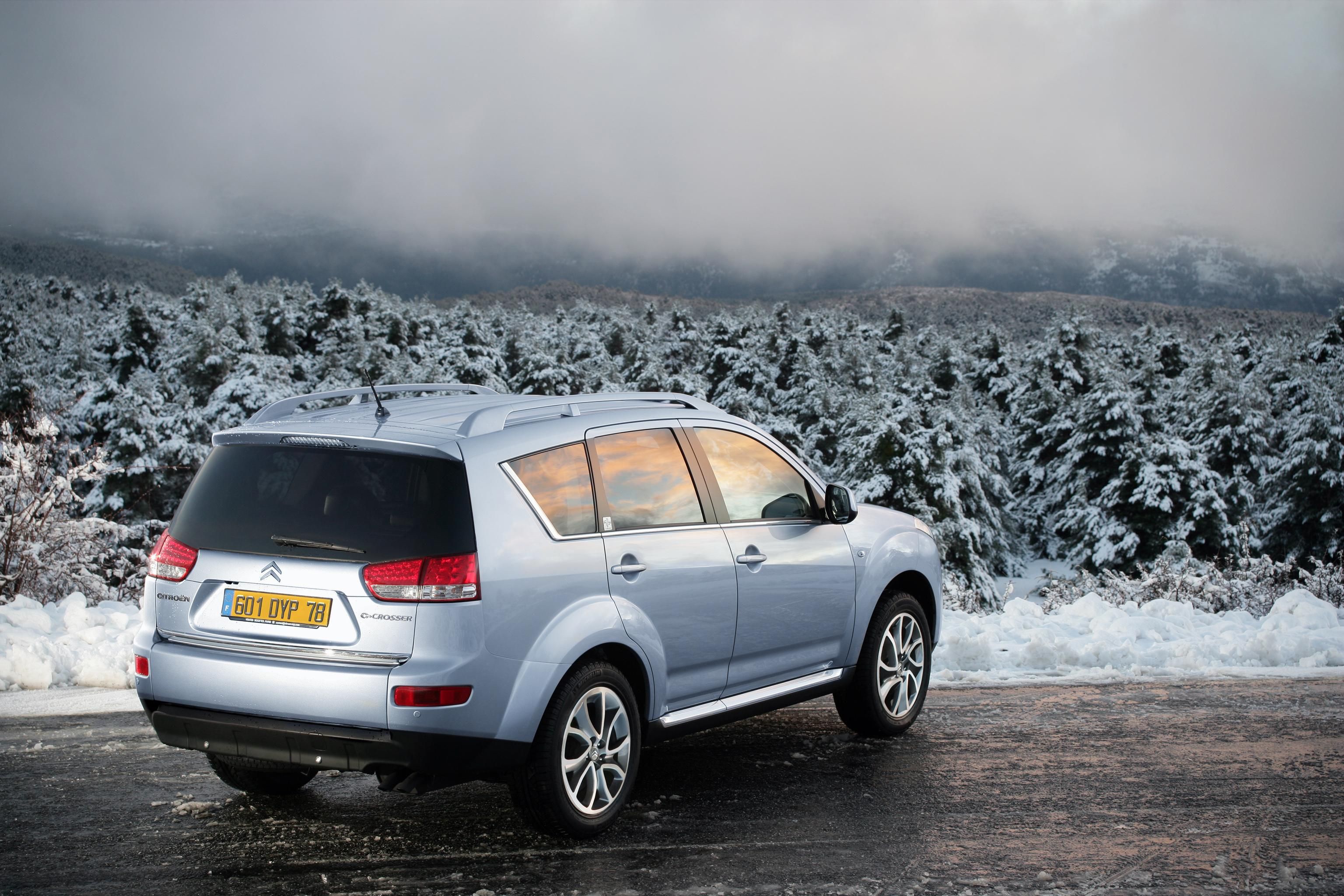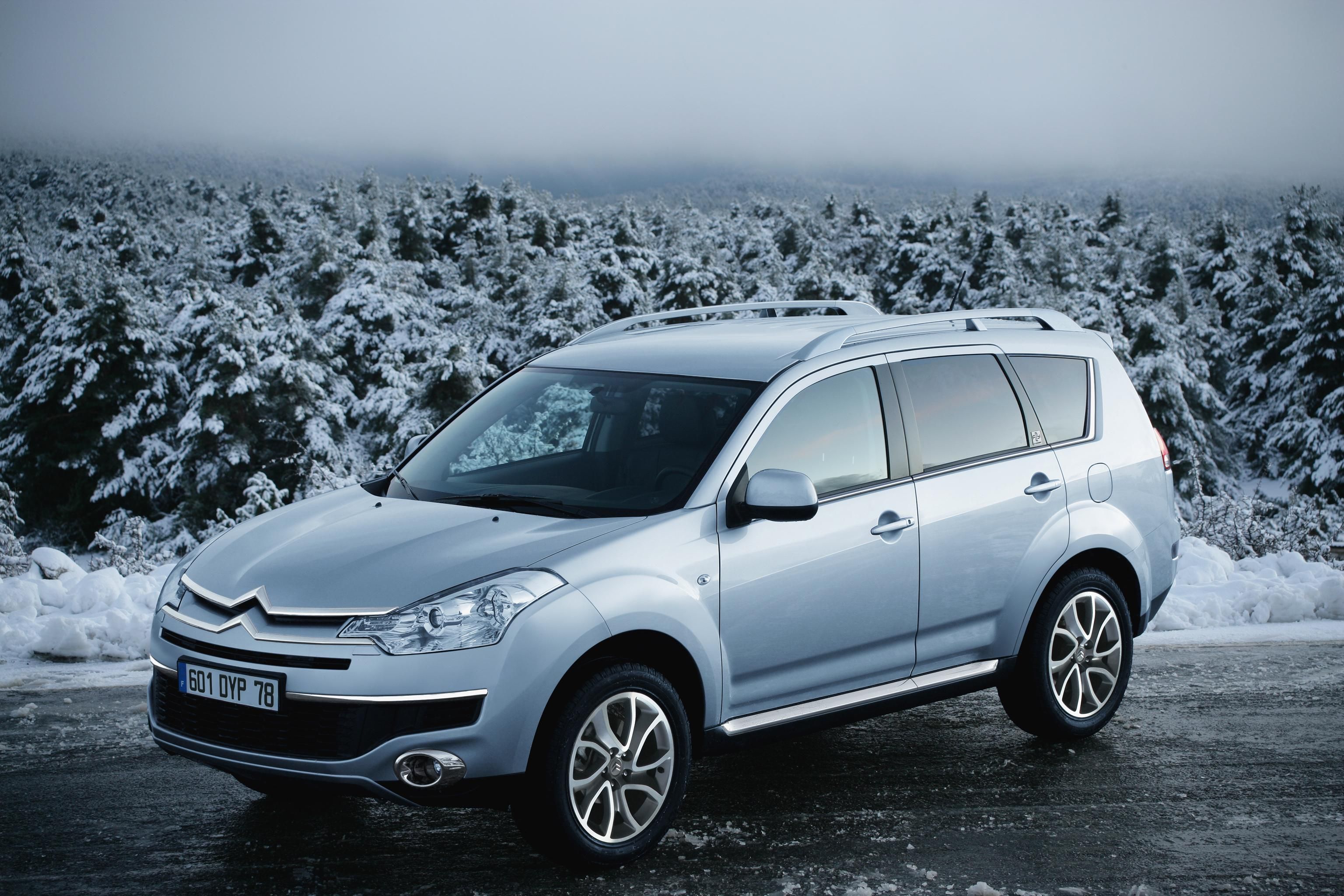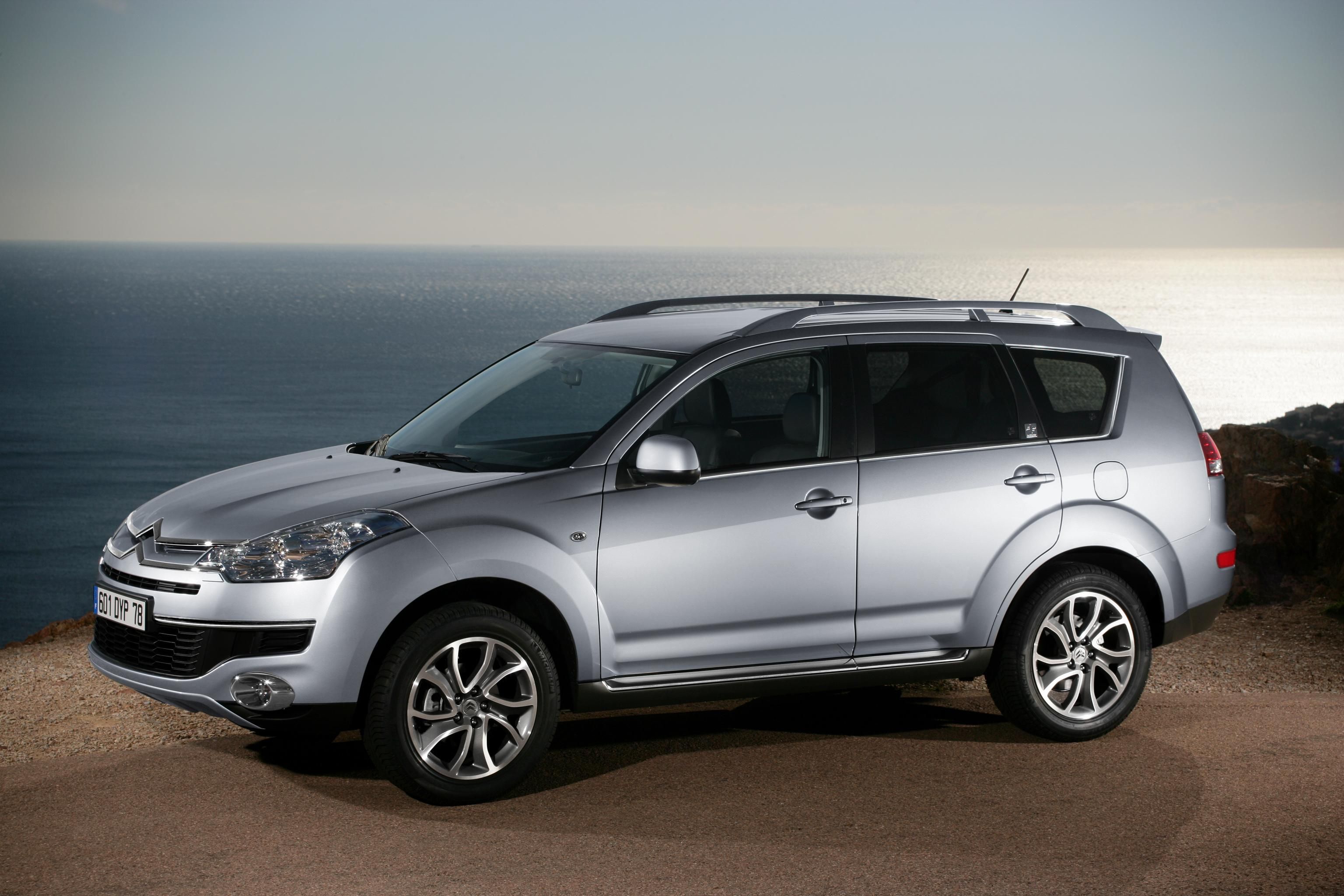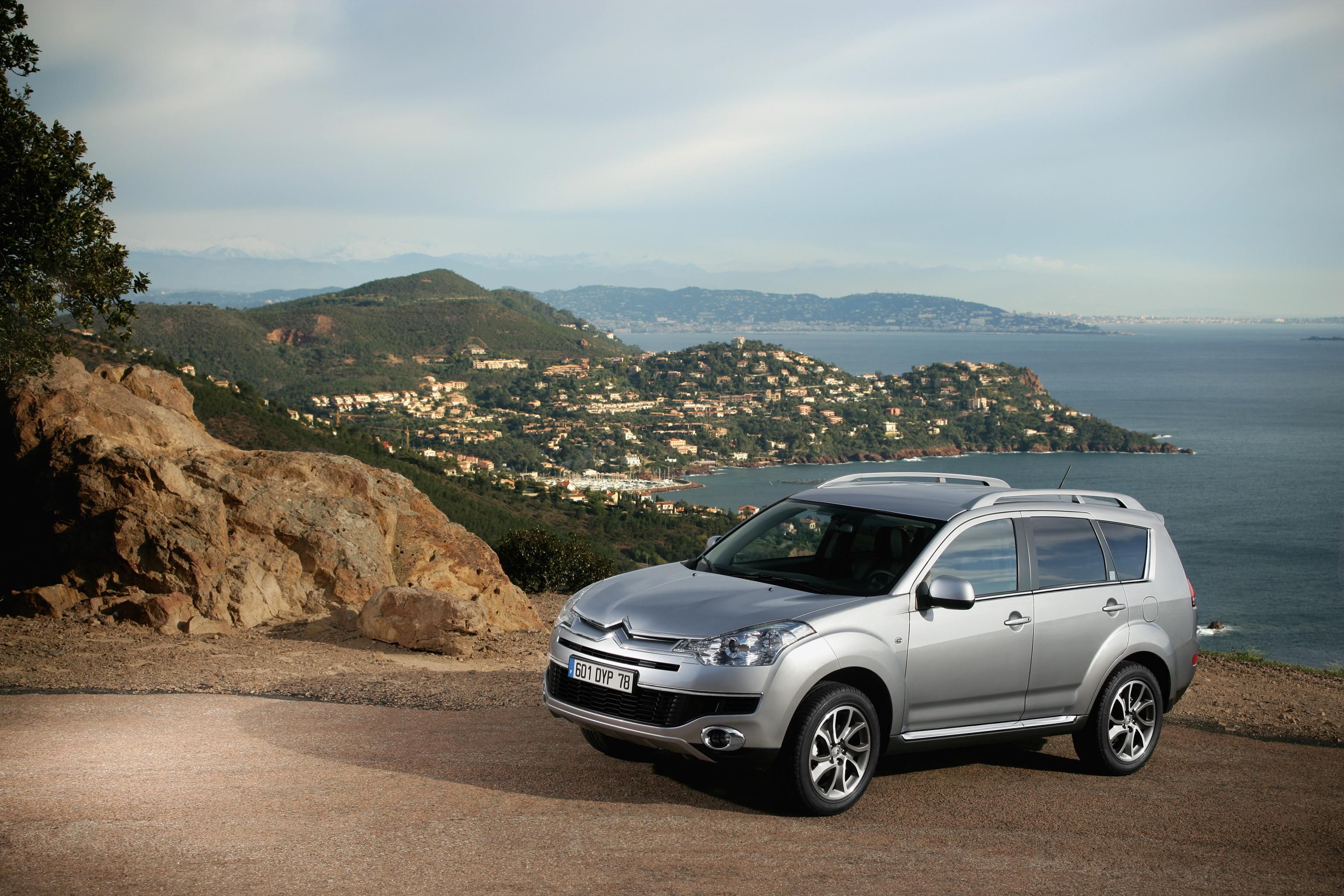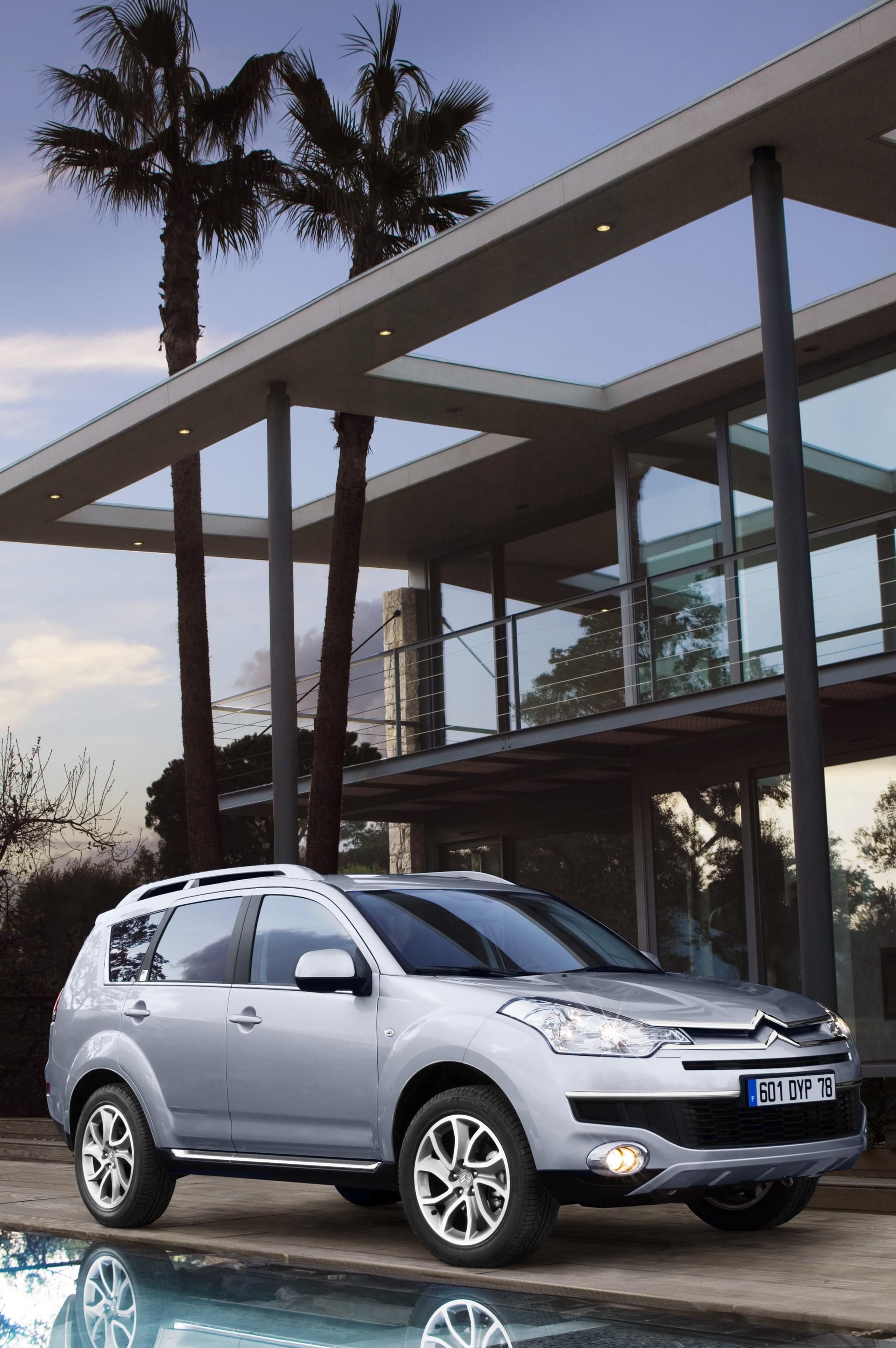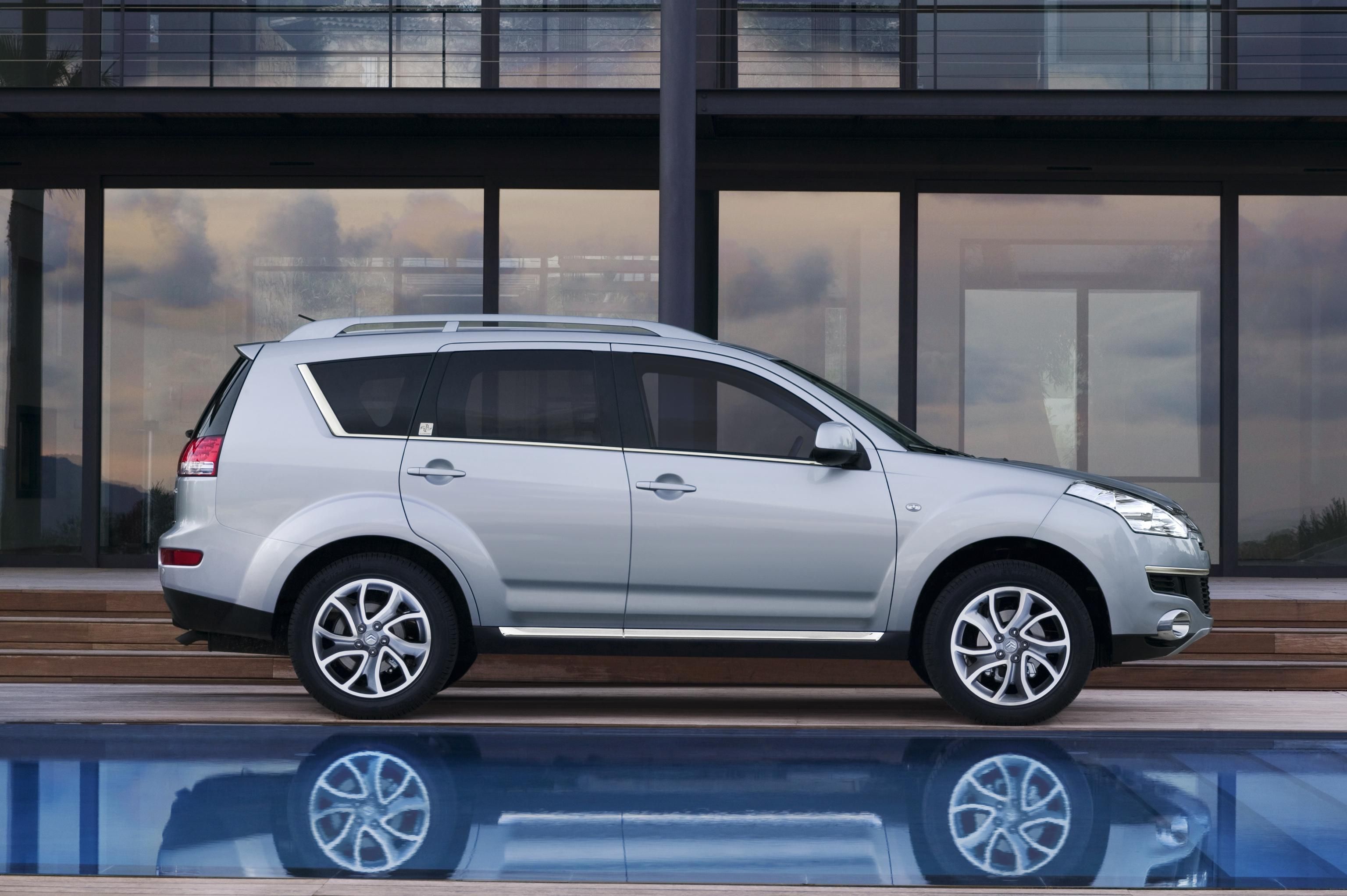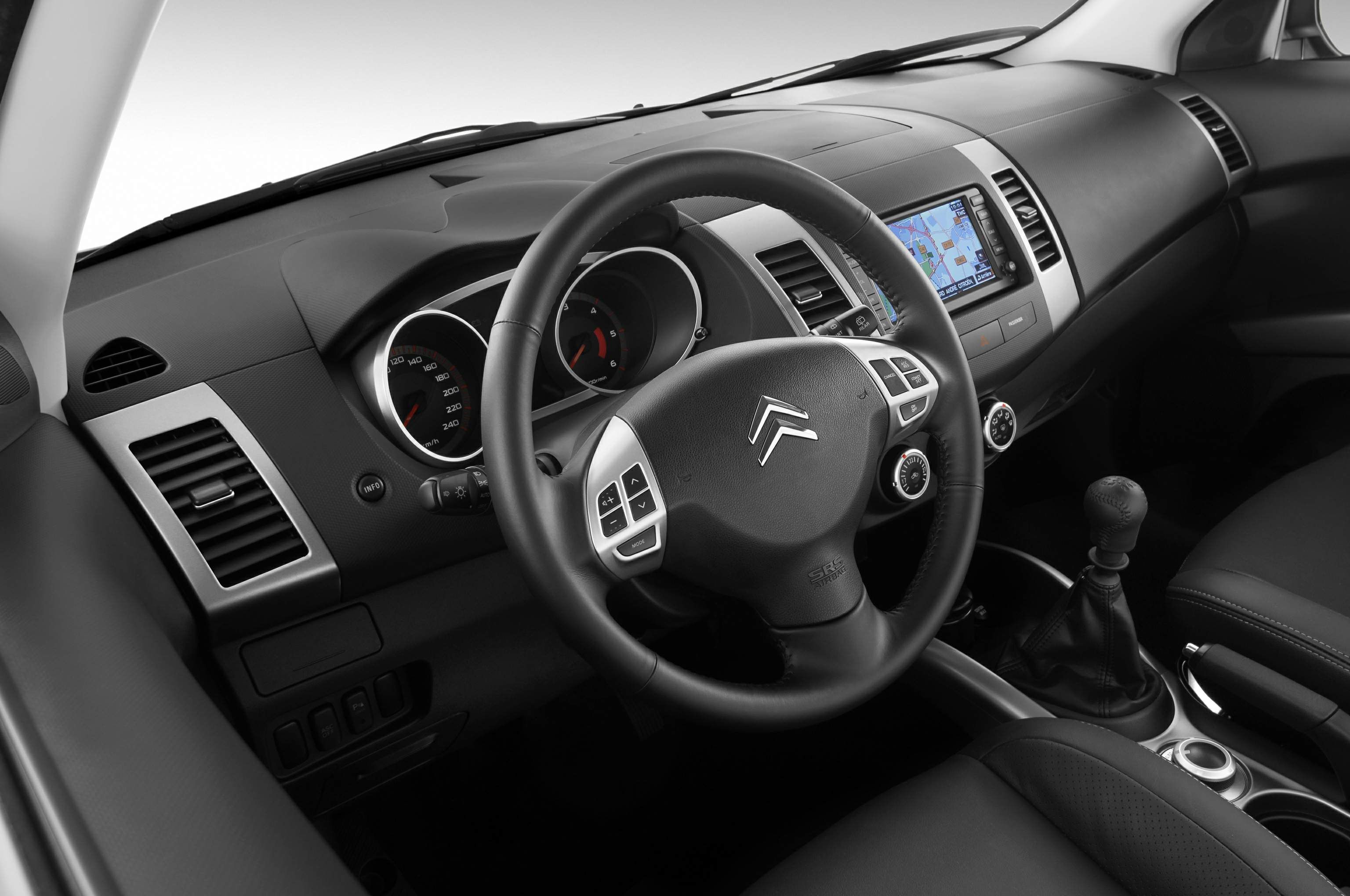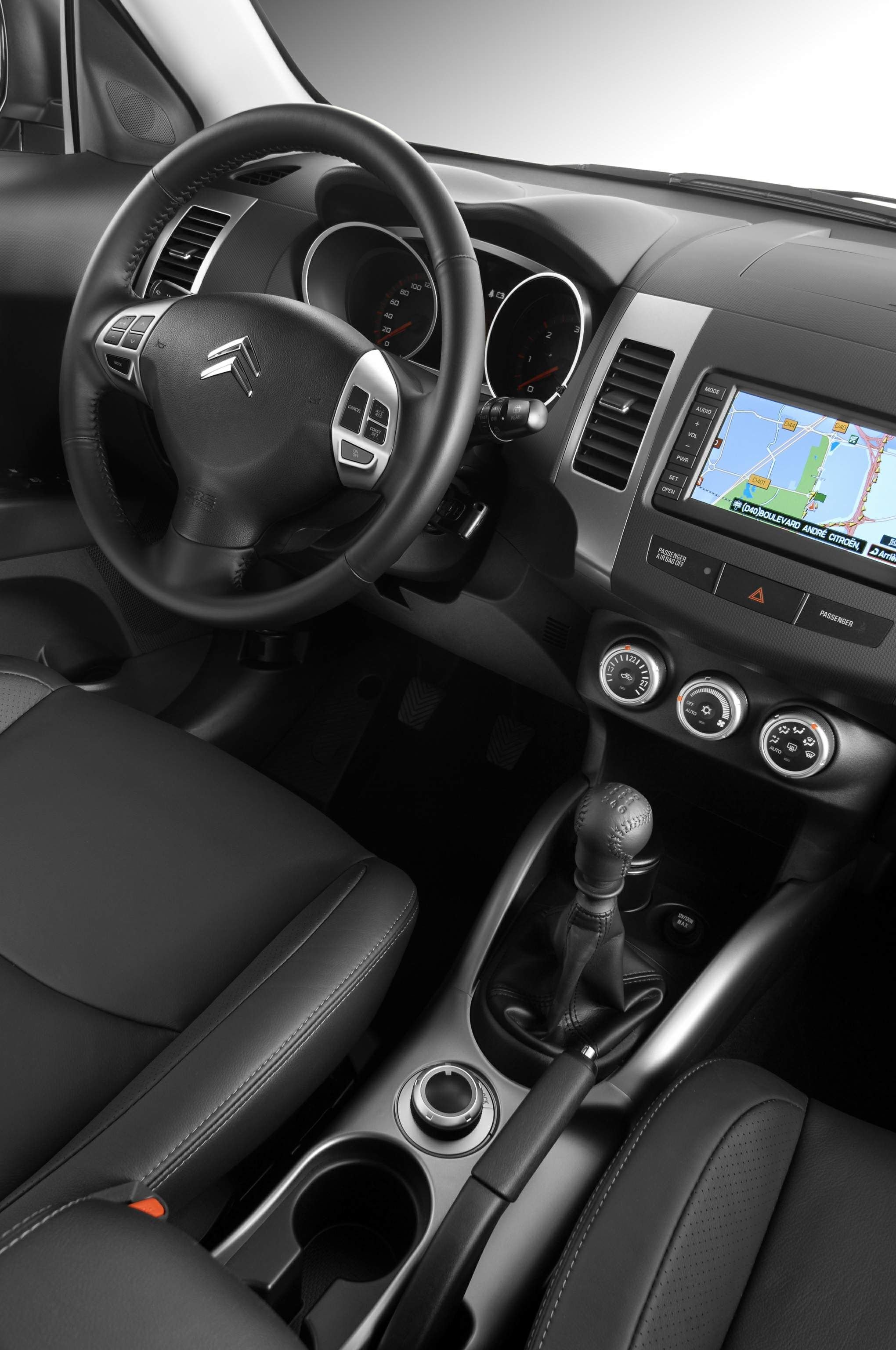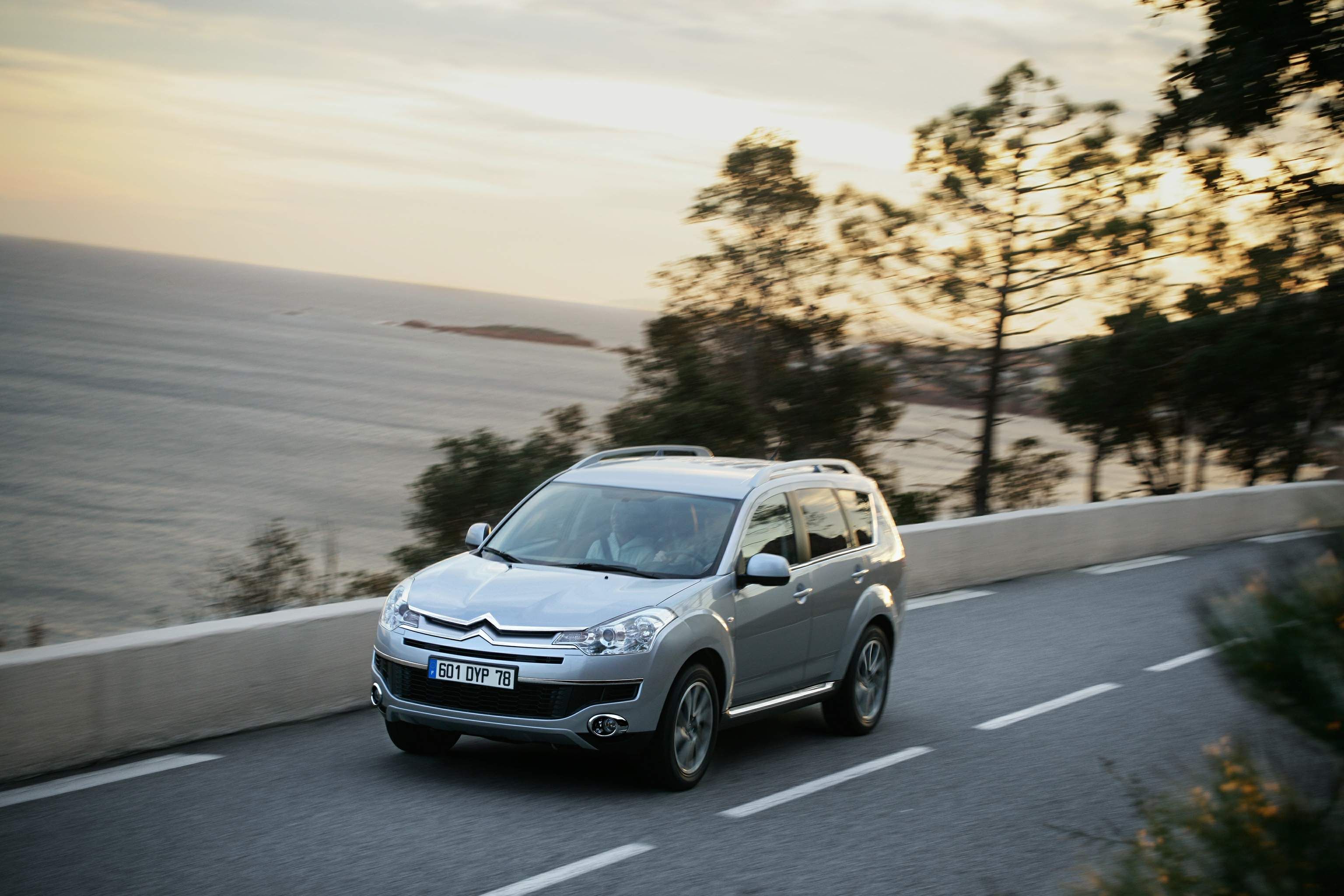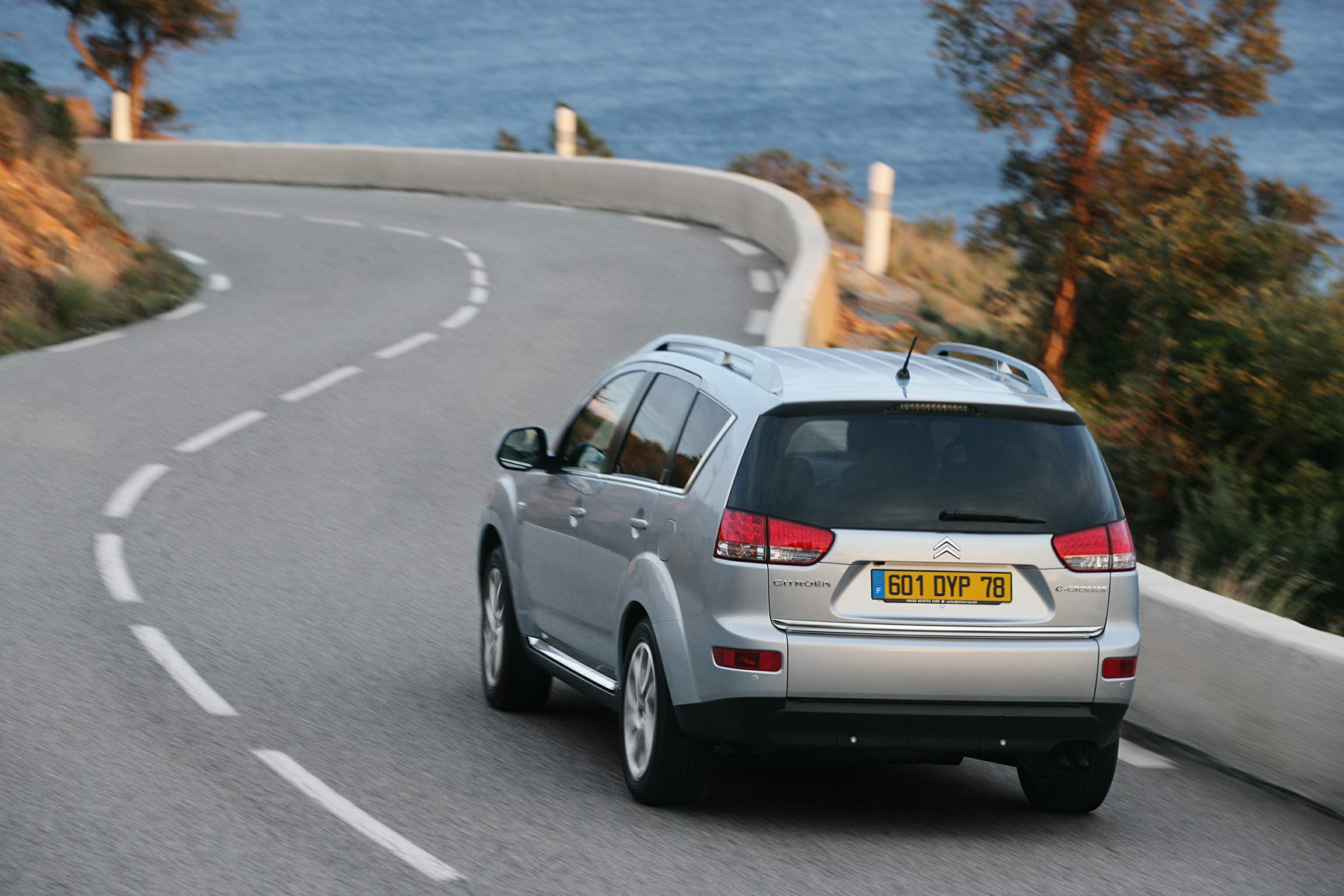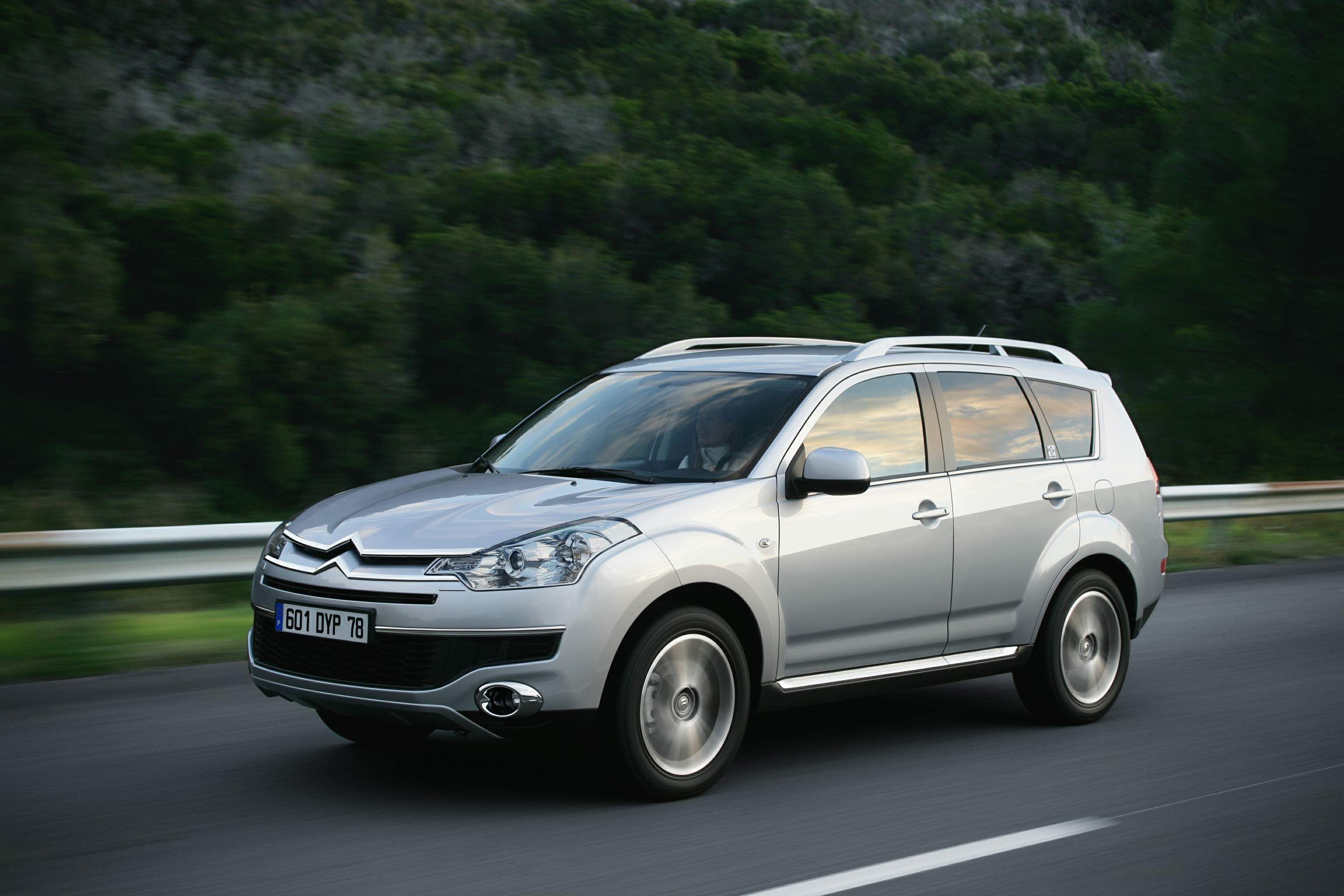The C-Crosser, Citroën’s new high-end SUV, has a number of aces in its pack. It boasts attractive, prestige styling, a 5+2 seat configuration with easy-to-use modularity, all-wheel drive for real versatility in use, and a HDi diesel engine equipped with a particulate filter for class-leading performance and minimal environmental impact.
2008 Citroen C-Crosser
- Make: Array
- Model: 2008 Citroen C-Crosser
- [do not use] Vehicle Model: Array
Premiering at the Geneva Motor Show, the C-Crosser will be launched in Europe from summer 2007. Bearing all the design cues of the Citroën brand, its styling is a perfect blend of all-terrain muscle, sports-car vitality and luxury-saloon sophistication.
Designed without compromise, the C-Crosser is at home on all kinds of terrain in all kinds of weather, thanks to its all-wheel drive system. Featuring 5+2 seats, sliding and folding row-2 seats and a flat floor, the CCrosser’s modular cabin allows for manifold configurations.
On the road, Citroën’s new SUV is extremely responsive and dynamic, with an excellent trade-off between ride comfort and roadholding, while the HDi diesel engine, fitted with a particulate filter (DPFS), minimizes the vehicle’s environmental impact.
The C-Crosser is at ease both on the open road and on wilder terrain, pleasant to travel in both alone and with the family, and capacious enough inside for extra friends or for transporting large objects. Citroën’s new SUV was designed for people looking for a highly versatile vehicle that fulfils their desires for freedom and well-being.
Instantly recognisable as a Citroën, the C-Crosser’s exterior styling adroitly blends different genres that give it a sporty look, a go-anywhere attitude, and a sophisticated demeanour in line with its high-end positioning. This artful blend is also found inside the new SUV.
An original, expressive front end
At the front, the C-Crosser features an original chevron composition that brings the vehicle its own identity within the Citroën range and expresses the SUV’s power and prestige looks. The line of the bonnet conveys the vehicle’s solidity and showcases the chrome chevrons that extend across the grille and intersect with the assertive-looking headlamps. This emphasis on width, which underscores the C-Crosser’s powerful air, is strengthened by a succession of parallel lines and an air-intake grille that stretches right across the imposing bumper.
The chrome strips on either side of the number plate, the honeycomb-style air intake grille and the chrome fog lamps bring a touch of elegance to the C-Crosser and confirm its top-of-the-range positioning.
Dynamic profile and well-balanced proportions
With its elegant proportions (4.64 m long, 1.81 m wide and 1.71 m high with roof bars), rearward-flowing roof line, high waistline and curvaceous wings, the C-Crosser’s profile exudes vitality and robustness. The SUV’s sporty looks are underscored by the shape of the headlamps, which extend up the bonnet following the flow of the wheel arches, and by the body line that rises at the quarter-light and thus confirms the dynamic feel. The SUV’s powerful attitude is expressed in curvaceous wings that sit atop special Michelin tyres designed for roadholding and performance.
The C-Crosser’s top-end positioning is signalled, on the Exclusive trim level (or country equivalent), by tinted windows and chrome strips running along the waist line and the lower body line. The vehicle’s high-class appeal is also expressed by (Exclusive trim-level) two-tone, diamond wheels, whose proportions and design exude a sense of solidity and endurance, as do the aluminium roof bars.
Rear styling conveying confidence and stability
The rear styling of the C-Crosser is equally dynamic, robust and sophisticated. The wraparound rear bumper is perfectly integrated with the wheel arches, giving the car a powerful, assertive look. The rear features a chrome strip giving it an elegant aspect. The line of this stylish strip marks the point where the upper and lower tailgate meet, highlighting the practical nature of the C-Crosser’s split-opening hatch.
The lights also mix style and functionality. They boast high-tech design, with LEDs on the position and stop lights, while providing optimal lighting and low energy consumption.
Brand allegiance is underscored by chrome chevrons and badges, one for Citroën and one for the C-Crosser name, which is also repeated at both the front and the rear, marked under compass dials. This logo, a symbol of freedom, underlines the C-Crosser’s all-terrain nature.
Consistent styling inside and out
The dynamic styling of the C-Crosser exterior continues inside the vehicle. Each function on the purely designed dashboard is clearly displayed and intuitive to use. The shape of the aluminium-surround dials and the design of the instruments on the cluster boost the SUV’s sporty appeal. The driver’s station features a leather-upholstered steering wheel and semi-bucket seats for excellent driving control and optimum pleasure at the wheel.
The passenger seats also offer plenty of support, and look good, too: Citroën paid close attention to interior finish quality to firmly position the C-Crosser as a top-end vehicle. The grain and soft paint of the dashboard, the special seat upholstery and the luxury door-panel trim create a harmonious, quality feel right down to the smallest detail.
-----
Interior
The C-Crosser is a true family car with its 5+2 seat configuration boasting easy-to-use modularity. The vehicle’s generous dimensions (2.67-metre wheelbase) house comfortable living space, numerous stowage compartments and an enormous boot with a split tailgate for easy loading. The C-Crosser adds the agreeable to the practical with a range of sophisticated equipment for extra onboard comfort.
Easy-to-use modularity
The C-Crosser features easy-to-use modular design. Occupants can make interior changes both quickly and effortlessly. With its occasional two-seater bench in row three, the vehicle can seat up to seven passengers. The bench folds away completely into the floor for a perfectly flat and impressively capacious loading surface. Access to row three is made easier by full-tilting, sliding seats in row two and two aluminium-coloured bars attached to the side panels in the boot. Passenger safety is enhanced by two retracting head rests and two safety belts with inertia reels anchored to the pillar.
The seats and seatbacks in row two can split-fold 60/40. For passenger comfort, the seat backs have three adjustable positions and both parts of the bench feature independent fore-and-aft adjustment over 80 mm. Row two can be manually folded, portfolio-style, against row one, using handles located on either side of the seats, or automatically, with two electric controls on the left-hand and right-hand sides of the boot above the wheel arches. This folding function provides a large loading surface and a flat floor.
Enormous, practical boot
Boot volume under the parcel shelf is among the largest in the category. In its most commonly used, 5-seater configuration (with row 3 folded away), the C-Crosser offers 510 litres (VDA standard) with row 2 seats pushed fully forward, and 441 litres VDA with row 2 seats as far back as possible. With all the back seats folded away, boot capacity totals 1,686 litres VDA.
Another C-Crosser strong point is its split-opening tailgate. When open, the lower part of the tailgate optimises the advantages of the flat floor of the luggage compartment, as it can be used for sliding in bulky or heavy objects, and even as a seat (supporting up to 200 kg). It also makes it easier to load the boot, since it lowers the sill by 640 mm. When closed, the entire height of the boot, and thus all its load capacity, can be used.
The upper part of the tailgate, used regularly, is light and compact for easy use.
Yet another practical boot feature is the soft luggage blind, which has two positions to take into account the tilt of the seats in row two. In addition, two aluminium side rails and four lashing hooks can be used for attaching accessories like the separation or storage net. A 12-volt socket is located on the left-hand side of the boot, and tools for fitting the spare wheel are housed in one of the boot’s two stowage bins. The spare wheel is placed under the body to free up interior space and also to avoid having to unload the boot to get at the spare wheel.
Functional storage
The C-Crosser cabin features a total of 22 stowage compartments, sized and designed with passengers and practicality in mind.
At the front, passengers benefit from a closed compartment on the top of the dashboard, along with two glove boxes: the one at the top has a heating or cooling function (depending on whether the occupants are heating or air conditioning the cabin) and a knob to switch this system off; the other boasts large capacity and can be locked.
The central arm rest features fore-and-aft adjustment (sliding 65 mm with a simple push or pull) and a splitopening function. The generously sized lower part houses a 12-volt socket, while the upper section can hold small objects. Both front doors are fitted with cubbies and a bottle holder. There is also a range of stowage compartments for everyday objects, such as glasses, pens, cards and cups, along with a removable ashtray.
The middle seat in row two contains an arm rest with two cup holders. The front seats get map pockets, while those in the back have cubbies with space for a bottle. Passengers in row three benefit from a stowage compartment located on the right wheel arch. The boot is equipped with two storage bins placed behind the wheel arches. The left-hand bin houses the subwoofer for the optional top-end stereo system, while the right-hand bin is for the spare wheel tools.
Top-of-the-range equipment
To enhance onboard comfort, the C-Crosser is available with a broad range of high-tech equipment.
- High-quality audio pack The C-Crosser comes with an optional audio system developed by specialist company Rockford Fosgate to provide passengers with a customised, high-performance sound experience. The system features 8 speakers judiciously placed around the cabin, a subwoofer (housed in the left-hand side of the boot), and a 650-watt amplifier, placed under the front passenger seat. Driver and passengers enjoy excellent sound quality, with optimised acoustic reproduction and sound distribution in all circumstances.
- New-generation navigation system The C-Crosser is available with a navigation system including a tactile 7-inch colour screen and a hard disk for rapid and quiet operation. The 30-gigabyte hard disk contains a European map database and reserves a third of its capacity for music storage. C-Crosser passengers can thus record up to 2,500 MP3/WMA-format songs.
- A reversing camera for easy manoeuvres For trouble-free parking in the tightest spaces, the C-Crosser has a reversing camera that is linked to the optional navigation system. The camera, located above the registration plate, is activated automatically when the driver shifts into reverse. The image it captures is displayed on the navigation screen. Two green lines superimposed on the image inform the driver of the vehicle’s future position if it were to reverse.
- Bluetooth, to make and receive telephone calls safely The C-Crosser can be fitted with a hands-free Bluetooth system, a convenient and safe option for making incar calls from a mobile phone, since drivers can make and receive calls without taking the phone out of their pocket.
With this option, the driver can make a call by using the voice recognition function (in French, English, German, Italian and Spanish) or the dedicated controls located on the steering wheel, to pick up and hang up.
-----
Driving Plesure
The C-Crosser is a pleasure to drive with its vivacious, environmentally-friendly diesel engine, and boasts responsive, dynamic road manners. Always a Citroën strong point, the running gear of the C-Crosser provides an excellent trade-off between comfort and roadholding. Peace of mind at the wheel also results from the vehicle’s all-wheel drive system and a full range of top-level safety functions.
A high-performance diesel engine that respects the environment
The C-Crosser will be available at launch with a new 160 bhp (115 kW or 156 bhp EEC) HDi diesel engine fitted with a particulate filter (DPFS) and mated to a six-speed manual gearbox. With its 2.2-litre capacity, variable-geometry turbo, generous torque and DPFS, this engine is at once flexible, smooth and frugal, and respects the environment. It develops 156 bhp at 4,000 rpm and a full 380 Nm of torque at 2,000 rpm, while boasting fuel consumption of 7.3 l/100 km over a combined cycle and CO2 emissions of 194 g/km.
One of the new-generation HDi engines developed in partnership with Ford Motor Company, the engine is based on the 173 bhp HDi DPFS unit available on the C5 and C6. It benefits from a variable-geometry turbo and a new combustion chamber, the ECCS (Extreme Conventional Combustion System), which optimises the air/fuel mix, along with a third-generation common rail system, in which pressure is increased to 1,800 bars for finer fuel spray. This combination cuts pollutant emissions and fuel consumption while improving performance.
The engine also gets two balancer shafts that significantly limit vibrations and increase driving pleasure. Particular attention was also paid to soundproofing the engine compartment for a peaceful interior ambience.
Optimised running gear
The characteristics of Citroën’s first SUV are thoroughly up to brand standards following the considerable efforts made on the original vehicle to provide the C-Crosser with the best possible trade-off between ride comfort and roadholding. The vehicle is fitted with MacPherson-type suspension at the front and multi-link axles combined with a large track and a 20 mm anti-roll bar at the back, for enhanced vehicle stability and active safety. The multi-link rear axle and its geometry provide excellent comfort by maintaining load height. The C-Crosser thus combines a top-flight ride with impeccable roadholding for segment-leading driving pleasure and handling.
This achievement is boosted by 18-inch wheels fitted with special 225/55 R18 Michelin tyres. The centering, linearity and elasticity of the steering system have also been engineered to optimise comfort, whatever the road surface. The C-Crosser features hydraulic variable-assistance power steering with a decreasing-flow pump, thus linking the system to engine speed.
To round out its road prowess, the C-Crosser has an aluminium roof weighing 5 kg less than a metal equivalent and lowering the centre of gravity by 4 mm.
High-performance brakes
The C-Crosser brakes were developed to respect Citroën standards on brake pedal feel in terms of bite, pedal pressure and efficiency. The C-Crosser’s braking system features ventilated discs with twin-pot callipers at the front and discs at the
rear, combined with ABS and electronic brakeforce distribution (EBD).
Standard equipment also includes the Electronic Stability Program (ESP), which can be deactivated using a button on the fascia band to the left of the steering wheel. It is coupled with traction control to prevent skidding.
All-wheel drive for safe journeys
With the C-Crosser’s all-wheel drive system, drivers get to choose from three transmission settings, depending on road conditions and driving style: two-wheel drive, four-wheel drive and lock mode, all of which are selected using a single control behind the gear lever.
- Two-wheel drive: used on tarmac-surfaced roads, guaranteeing high grip (dry road). The vehicle has a front-wheel drive 2WD system, which cuts fuel consumption by reducing the number of parts in movement.
- Four-wheel drive: this is the recommended setting as the torque split between front and rear axles is managed automatically. The front wheels turn more than the rear wheels. Torque is electronically distributed to the rear wheels by an electronic control unit (ECU) according to grip conditions, for optimal roadholding in all circumstances.
- LOCK mode: recommended for reduced grip conditions (snow, sand or mud). In this setting, the ECU sends 1.5 times more torque to the rear wheels than in 4WD mode, increasing traction through a better front/rear balance. This “on request” transmission system is managed by an ECU that automatically varies the torque split between the front and rear wheels for maximum traction. The ECU factors in information including:
- vehicle speed,
- steering angle,
- the difference in rotation speed between front and rear axle,
- the pressure on the accelerator pedal.
With this new-generation all-wheel drive system, the C-Crosser can run permanently in 4WD mode with optimal front/rear torque distribution, providing optimised roadholding in all driving conditions and thus maximum safety.
Top-level passive safety
Vehicle structure for passenger and pedestrian protection
Considerable effort was devoted to the structure of the C-Crosser in order to comply with the most stringent passive safety assessment standards. The structure was reinforced using high-strength steel to limit deformation in the event of impact. The front side members were specially designed to absorb energy, as were the padding and the reinforcing beams in the doors, contributing to occupant protection in the event of side impact.
All these features give the C-Crosser’s structure the required stiffness for protecting occupants during highspeed impact and the flexibility necessary for absorbing lighter impact.
The structure of the C-Crosser’s front end was designed to ensure car-to-car “crash compatibility” in the event of collision with a conventional vehicle, thus offering efficient protection for C-Crosser passengers and reducing the risk of injury for occupants in other vehicles. To limit the consequences of pedestrian impact, the C-Crosser is fitted with:
- boot and wings designed to crumple, with ample space between the panels and the internal structure to
- absorb impact,
- bumpers fitted with polyurethane foam that absorb energy in such a way as to reduce injury to the legs.
Six airbags fitted standard
The C-Crosser is fitted as standard with two front airbags (driver and passenger), two front side airbags and two front/rear curtain airbags. The two front airbags are adaptive, with deployment pressure and volume correlated with the severity of the
impact.
The passenger airbag can be deactivated using the ignition key, in order to install a child seat at the front. An indicator on the instrument cluster informs the driver that the airbag has been deactivated.
Efficient restraint systems
All the seats in the C-Crosser (5+2) are fitted with safety belts with three anchor points. Driver and front passenger belts also feature pyrotechnic pretensioners and load limiters, to reduce pressure on the chest in the event of impact.
If front passengers are not buckled up or safety belts are unfastened in row two during the journey, an alarm is signalled and a message appears on the instrument cluster. Finally, Isofix anchor points are available for fixing child seats to the side seats in row two.

